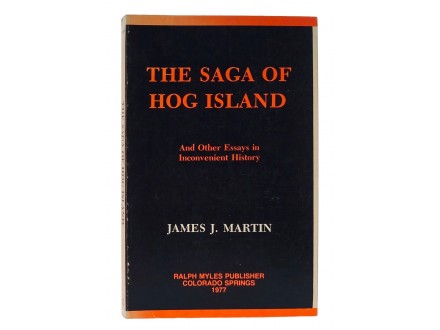The Saga of Hog Island - James J. Martin
| Cena: |
| Želi ovaj predmet: | 1 |
| Stanje: | Polovan bez oštećenja |
| Garancija: | Ne |
| Isporuka: | Pošta CC paket (Pošta) Post Express |
| Plaćanje: | Tekući račun (pre slanja) |
| Grad: |
Novi Sad, Novi Sad |
ISBN: Ostalo
Godina izdanja: 1977
Jezik: Engleski
Autor: Strani
U dobrom stanju
The Saga of Hog Island: And Other Essays in Inconvenient History Paperback – January 1, 1977
by James J. Martin
Publisher : Ralph Myles; First Edition (January 1, 1977)
Language : English
Paperback : 208 pages
ISBN-10 : 0879260211
ISBN-13 : 978-0879260217
Item Weight : 11.2 ounces
Martin`s additionist essays are historical correctives that have relevance to events today. The first essay tells the story of the massive world war 1 ship building yard built at Hog Island, now the site of Philadelphia International Airport. Legend has it that the `Hoagie` sandwich may have had it`s origin among the many Italian American shipyard workers. At it`s peak as many as 36,000 workers were employed on Hog Island yards. This vast facility was established to mass produce cargo ships for the WW1 war effort, along the lines of the more famous `Liberty Ships` of WW2. But the program was dogged by scandal and massive accounting `incompetence`. In the end Hog Island, owned and operated by a consortium who`s membership register reads like a `Who`s Who` of the American business and industrial elite, delivered 122 ships that cost of `at least` $235 million to build (that is $2.4 billion in 2007 dollars, ~$20M each). Most of the ships were ultimately sold for a mere $35,000 each ($353,000 in 2007 dollars). Hog Island itself was a part of a larger web of mismanagement that embraced the Shipping Board and the Emergency Fleet Corporation. `Alfred D. Lasker, who assumed the direction of the Shipping Board under President Harding, on July 16, 1921 decalred that the total government `loss` on the ship construction, operation and leasing activities during the World War came to $4,000, 000, 000- double the figure originally thought.` Corrected for inflation, those 1921 dollars amount to approximately $40.3 billion in 2007 dollar terms. In a January 31, 2005 CNN article published under the headline `Audit: U.S. lost track of $9 billion in Iraq funds`. `Nearly $9 billion of money spent on Iraqi reconstruction is unaccounted for because of inefficiencies and bad management, according to a watchdog report published Sunday.` It`s probably not being over dramatic to say that the vast `losses` in US military-industrial spending represent part of a 90 year tradition of apparently unending fiscal incompetence.
On the 10th January 2000, `The Weekly Standard` declared that Winston Churchill was `Man of the Century`. In his second essay `The Consequences of World War Two to Great Britain: Twenty Years of Decline, 1939 -1959` provides a much needed tonic to Churchill worship, and his elevation to the status of prophet, as regularly recycled by the History Channel and George W Bush`s bedside reading. In 1942 Churchill declared `I have not become His Majesty`s first minister to preside over the dissolution of the British Empire.` Yet to a large extent that was his real legacy as Martin explains. Martin`s piece also illustrates the extraordinary fickleness of many American conservatives. Ever ready (and probably rightfully so) to condemn FDR for bending over too far to accomodate Josef Stalin, FDR`s `willing accomplice` Winston Churchill largely escapes scot free from conservative criticism. Yet less than a year before his famous 1946 Fulton Missouri `Iron Curtain` speech, Churchill was praising Comrade Joe in parliament. Perhaps had FDR, who died in April 1945, had lived another year he would have had time to perform a public somersault too.
Martin provides an eye opening essay on Mussolini`s campaign against the mafia. Like most students of history I had heard of this but had assumed Mussolini must have conducted some kind of fascist purge or authoritarian `round up` of mafiosi. Not so. Mussolini`s campaign was quite civilised with the accused being provided legal rights and indeed many accused successfully defended themselves against the charges and walked free. Still despite these `handicaps`, Mussolini`s lawful and orderly campaign against the mobs was one of the largest and most successful campaigns against organised crime anywhere, and much of it`s gain was unravelled by a mixture of postwar chaos and some allied cooperation with the mafia. Martin explores this last angle too. Many of us have heard of Lucky Luciano`s claims to have helped protect the New York waterfront from German saboteurs and to have aided the allied advance across Sicily. These stories indeed have become legends of sort. Martin sees them as shameless self promotion from a crook on the make. The allied armoured and amphibious campaign in Sicily wasn`t dependent on local mafiosi to show them goat tracks behind the Axis lines.
Martin has three essays on the Pacific War. Only one could really be called revisionist. In `Pearl Harbor: Antecedents, Background and Consequences` he outlines the background to Japanese-American rivalry in the Pacific in the decades and days before Pearl Harbor. Usually `the revisionist position` here (as if there were just one) is summarised as the claim that FDR engaged in a conspiracy over Pearl Harbor. The old mainstream belief that FDR was really an innocent victim of a surprise attack has now largely been dismissed from serious scholarship, thanks to decades worth of unpraised work by revisionist historians. The new mainstream belief is that the unheeded warnings of imminent attack were mishandled. Administrative incompetence rather then conspiracy provides a better explanation. The revised mainstream account arbitrarily assumes incompetence and conspiracy are mutually exclusive categories. More to the point was `Rainbow 5`, the then secret ABDA (Australian-British-Dutch-American) agreement `..to fight the Japanese in Asia if their forces crossed a geographic line..[which]..approximated the northerly extremity of the [Dutch East Indies].` The US government was advised that the Japanese had crossed the magic line on December 3 (Washington time) and that America`s allies naturally expected the US government to live up to it`s agreements. The apparent mishandling of reports concerning Japanese fleet movements in the northern pacific need to be considered with the ABDA timeline in mind. Considering the great difficulty the administration had in having conscription passed in Congress, it squeaked through by just one vote, a certain degree of planned incompetence, an art form familiar to anyone who has worked in a bureaucracy can attest to, is not an unreasonable explanation (although one inherently and deliberately hard to prove). Nor is such a hypothesis equivalent to Roswell UFOs or the Bavarian Illuminati as anti-conspiracists like to maintain.
Martin also essays the stories of Colin Kelly and `Tokyo Rose`. Kelly was an airman who died early in the Philippines campaign after his aircraft was hit following an indecisive attack on a second or third tier Japanese vessel, probably a supply transport. In the dark days of continuous bad news from the Pacific his deeds were inflated to legendary status by the media, and indeed the administration, until it sounded as if he single handedly sank a battleship in a one-man kamikaze attack. Subsequent revisions of the official account deflated the Kelly story down to a footnote before disappearing in later versions. The whole story seems to echo in the 2003 Jessica Lynch story. Times indeed have changed, the spin cycle is faster these days. The `Tokyo Rose` essay details how a soldiers` myth, that there was one seductive Japanese propaganda broadcaster luring GIs with tales of unfaithful girlfriends back home, led to a miscarriage of justice that scarred the life of Iva Toguri, a young Japanese American woman accidentally caught up in Japan whilst visiting family in the days surrounding Pearl Harbor. Toguri, one of many english language broadcasters was made carry the can for the lot. With the boom in recent years of feminist and multicultural studies, all under the history banner, it is surprising that Martin`s `The Framing of Tokyo Rose`, especially with it`s hints of sexuality, hasn`t become a standard in gender studies. This too has modern references, and not just in the United States. The current `War on Terror` is leaving in it`s wake a growing `bodycount` of innocent bystanders caught at the wrong place, often to become the victims of tragic miscarriages of justice as government security apparatus strikes out at it`s elusive quarry.
The book is rounded off with three brief appendix essays, essentially magazine articles. The first compares the blacklists imposed on Axis commerce in South America by the US in the years before Pearl Harbor to the attempted Arab boycott of jewish owned firms in the US in 1975. The second discusses the Morgenthau Plan and the third is a brief history of political assassination in the first half of the 20th century. The last article is definitely the best, the Morgenthau Plan article is not comprehensive and seems to have been prematurely ended, neglecting to cover it`s demise and the boycott article seems to me to be `drawing a long bow`. The Rockefeller administered Axis boycott in South America, whatever else it was, was part of an actual economic warfare plan, the Arab boycott barely deserved the name and was almost entirely a propaganda campaign lacking serious enforcement teeth. If anything it probably boomeranged and hardened international opinion against the Arab campaign.
`The Saga of Hog Island` is recommended to anyone interested in modern history.
L_I_Č_N_O______P_R_E_U_Z_I_M_A_NJ_E_:
Za kupovine ukupne vrednosti preko 3.000 dinara moguće lično preuzimanje u Puškinovoj u Novom Sadu. Ako je za pojedinačnu knjigu navedena samo opcija Pošta, lično preuzimanje samo te knjige nije moguće. U Novom Sadu moguća je lična dostava i plaćanje preko službe Eko-kurir (cena je 250-350 din).
STANJE KNJIGE:
Knjiga koju dobijate je ona koja je na slici. Ukoliko nije naznačeno da je knjiga nova ili nekorišćena, ponekad se desi da na predlistu stoji potpis, posveta ili pečat i da to nije navedeno u opisu. Ako vam takve stvari smetaju, pitajte me pre kupovine da proverim.
KOMUNIKACIJA:
Komunikacija ide isključivo preko Kupindo poruka, ne telefonom. Budite normalni.
POPUSTI, CENKANJE I SL.:
Cena je ta koja piše, molim vas da mi ne šaljete pitanja o poslednjoj i zadnjoj ceni niti svoje kontraponude.
SLANJE:
Knjige šaljem kao tiskovinu ili CC paket nakon uplate na račun. Pakujem ih bezbedno i pažljivo, dobijate ih u stanju u kojem su poslate. Poštarina za jednu pošiljku obično iznosi od 190 do 260 din, u zavisnosti od težine. To je poštarina za tiskovinu, CC paket je skuplji, post ekspres je najskuplji. Za četiri i više pojedinačno kupljenih knjiga (u to ne spadaju kompleti) ja snosim troškove poštarine. Potrebno je da uplatite/preuzmete knjigu u propisanom roku od 7 dana.
SUSEDNE ZEMLJE I INOSTRANSTVO:
Poštarina je za jednu knjigu visoka i okvirno se kreće od 10-15 eur za prvu i oko 7 eura za svaku dodatnu knjigu. Postoji mogućnost znatno isplativijeg slanja za teže pakete. Uplate PayPalom (+10%), direktno na devizni račun, Western Union ili Moneygram. Najbolje je da pre kupovine pitate koliki su troškovi dostave, jer su često veći od cene same knjige.
INTERNATIONAL ORDERS:
I will send abroad. For your calculation, one hundred dinars roughly equals $1. Please register here:
https://www.limundo.com/Registracija/Kupindo
and then PM me on the link below for postage costs (they usually start at around 15 euro for the first book and 7 euro for each additional one)
https://www.kupindo.com/Clan/ndi/PostaviPitanje
MOJA PONUDA:
Nove knjige postavljam gotovo svaki dan. Možete ih pratiti na ovom linku http://www.limundo.com/Clan/ndi (pritisnite dugme `Prati`)
¤¤¤¤¤¤¤¤¤¤¤¤¤¤¤¤¤¤¤¤¤¤¤¤¤¤¤¤¤¤¤¤¤¤¤¤¤¤¤¤¤¤¤¤¤¤¤¤¤¤¤¤¤¤¤¤¤¤¤¤¤¤¤¤¤¤¤¤¤¤¤¤¤¤¤¤¤¤¤¤¤¤¤¤
Predmet: 75606581







